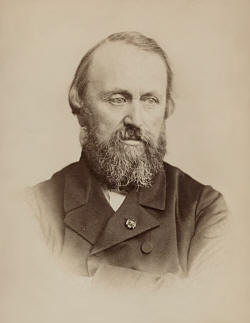

Queer Places:
Musée du Louvre, Rue de Rivoli, 75001 Paris
 Jean-Hippolyte Flandrin (23 March 1809 – 21 March 1864) was a 19th-century French painter. His celebrated 1836 work Jeune Homme Nu Assis au Bord de la Mer ("Young Male Nude Seated beside the Sea") is in the Louvre.
Jean-Hippolyte Flandrin (23 March 1809 – 21 March 1864) was a 19th-century French painter. His celebrated 1836 work Jeune Homme Nu Assis au Bord de la Mer ("Young Male Nude Seated beside the Sea") is in the Louvre.
Flandrin is known in the history of homosexuality for a single work, Jeune homme nu assis sun un rocher (Nude Young Man Seated on a Rock), begun in 1835 and finished the following year as a fourth-year study required by his fellowship. It portrays a curly haired ephebe seated with his arms wrapped around his legs and his forehead resting on his knees against a background of the sea and a rocky outcropping. Contemporary critics noted the influence of Piero della Francesca, Michelangelo and Ingres, and sometimes compared the painting to a medal or a cameo. Théophile Gautier wondered if the sad youth was a shepherd who had lost his flock or a voyager shipwrecked on a deserted island. The painting was purchased by Emperor Napoleon III in 1857 and it now hangs in the Louvre Museum in Paris. The image entered the homosexual gallery when Wilhelm von Gloeden, around 1900, took a photograph of a young man in the identical pose as the figure in Flandrin's picture. Later photographers, including Robert Mapplethorpe, have reinterpreted the scene, sometimes with direct quotation from the original. Though painted by a heterosexual and without a specifically homosexual theme, Flandrin's painting has become one of the most widely recognised and appreciated gay icons – for the pictorial beauty of the Mediterranean youth and perhaps, too, the mood of solitude and reflection – through reproduction on postcards, posters and book jackets.
In art history, the considerable accomplishments of Hippolyte Flandrin are often overshadowed by those of his mentor, J. A. D. Ingres (1780-1867). Flandrin adhered closely to Ingres's focus on purity and perfection of line. He also followed Ingres in expressing a reverence for the past and for classical themes and subjects. Both artists had an unusual way of mixing tradition with innovation.
_-_Jeune_homme_nu_assis.._1855_-_Louvre.jpg)
Jeune homme nu assis au bord de la mer (1836)
However, Flandrin's studies of male youth distinguish him from his master, especially insofar as these works are richly and suggestively homoerotic.
Flandrin came from an artistic family in Lyons. After moving to Paris, where he studied with Ingres, and following a five-year stint in Rome for further study, he quickly gained a reputation as a painter of mythological and religious scenes.
Later in the nineteenth century, art critic Théophile Gautier (1811-1872) equated Flandrin's purity of line and color with purity of emotion and spirituality. Flandrin himself was devotedly religious and approached his art from a spiritual rather than secular point of view. Many of his most ambitious projects were commissioned by churches such as Saint-Germain-des-Près and Saint-Vincent-de-Paul in Paris.
Nothing about Flandrin allows us to identify him as homosexual. He was married and had several children. He apparently did not consciously conceive of his work as homoerotic.
Many of his mythological scenes, however, concentrate on the youthful male nude as aesthetic object. Flandrin himself claimed that the classical beauty of his work was born out of his knowledge of Homer, Plutarch, Tacitus, and Virgil. The majority of his mythological scenes, produced between 1833 and 1836, feature secluded youthful nude males situated in calm and still environments.
Most of his figures express "a perfect peace" and mix Virgilian lyricism with a striking realism in the detailing of head, hands, and feet. In some of his works, he exploits compositional devices that cover the genital area but also focus attention on it. The homoerotic overtones of these works are profound.
One of these, Polytes, Son of Priam Observing the Movements of the Greeks Near Troy (1833-1834; SaintÉtienne, Musée d'Art et d'Histoire) shows a nude male youth sitting in profile atop a classically decorated pedestal. He looks out of the picture and into the distance. The prominent curve of the youth's back and the formal focus on the interplay between form and line communicate a quality of hushed beauty and frozen purity.
The work is implicitly erotic and imbued with a quality of meditative spirituality. One outstanding detail is the hyperreal rendering of the young boy's exposed pubic hairs. This detail seems to be at odds with the idealized quality of the rest of the painting. Flandrin thus blends the real and the ideal, the erotic and the contemplative, a poeticized romanticism and an incongruous realism, and classicized form and pious Flandrin's most popular and recognizable work is his Figure d'Étude (Nude Youth Seated on a Rock, 1835-1836; Paris, Louvre). Typical of Flandrin, this work uses the nude male figure as a showcase for the stylistic purity of line, modeling, chiaroscuro, and color. These features are underscored by a mysterious, meditative calm provoked by a moonlit seascape. The youth's body and the environment work together to evoke an aura of poetic lyricism.
The work has been hailed as an exquisite example of visualized spirituality and beauty. The painting is distinguished not only by a hyperreal rendering of the boy's arms, hands, and feet, but also by its geometric composition, which consists of an equilateral triangle within a circle, which may have mystical significance.
The curled up, fetal pose was a unique compositional invention and has subsequently been repeated by artists ranging from Edgar Degas to Baron von Gloeden to Robert Mapplethorpe. The pose is perfect for highlighting the male body as an object of spiritual and erotic contemplation.
My published books: